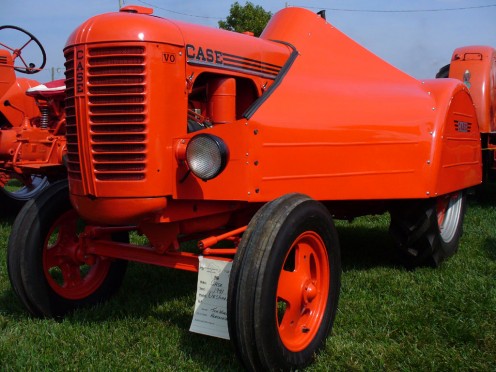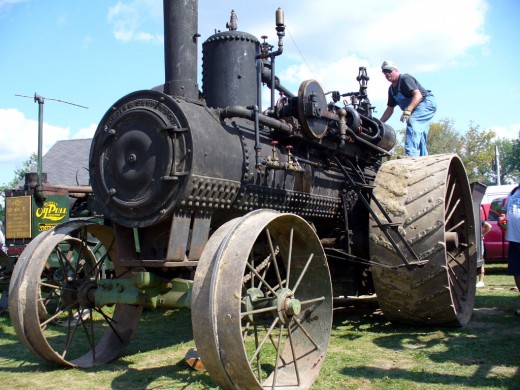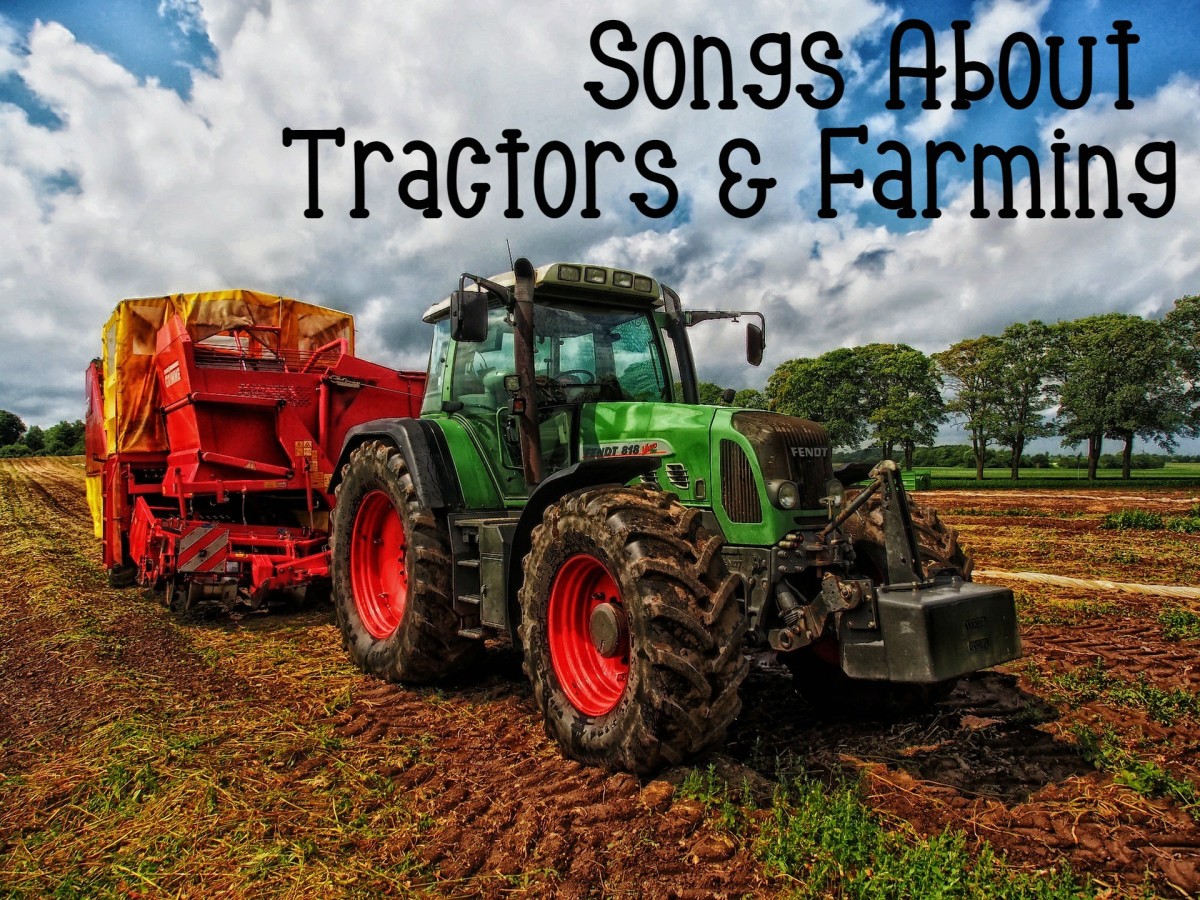Tractor Safety Course
May look good--but never speed with your tractor--at least, not when you're working on the farm.

Note the ROPS and seat belt--save a life--it will be your own.
When the tractor looked like a train--and certainly didn't run like a Deere

ROPS or RIP?
“Tractor accidents are the leading cause of death on farms in BC,” states Worksafe Hygiene Officer, Glen Dunsmore in a video slide show investigating the death of a BC farm worker. “800 farm and ranch workers are injured every year, and on average, four fatalities occur during any given year,” according to WorkSafe BC’s handbook entitled Agriculture Safety Checklist.
In Britain, it has been reported that “agriculture has the worst fatal accident and ill health records of any major employment sector,” by that nation’s Health and Safety Executive. It is a worldwide issue because of the “friend and foe” relationship that farmers, orchardists and ranchers must maintain with the most useful piece of equipment in the industry.
The tractor as the most useful, and the most dangerous, equipment on the farm requires attention in three major areas avoiding injury and death. The three areas of greatest concern are roll over; run-over and power take off accidents.
In recent decades tractor safety features and tractor designs have reduced some of the dangers for farm workers. Roll Over Protection Structures (ROPS) have created a protective zone for tractor operators when accompanied by the use of a seatbelt. Power Take-Off (PTO) shields have created a safer zone when working around the speeding revolutions of the PTO, which can eat eight feet of material in the blink of an eye. Low Profile tractors, for use in tight, low-ceiling structures or on orchards, have retractable ROPS and allowed greater use of today’s tractor.
Run over accidents are almost always the most devastatingly tragic. This area of accidental occurrences requires extensive operator safety measures. Never start a tractor while standing next to it—use a key, while in the operator’s seat and seatbelt buckled. Be aware of any other workers in the vicinity while operating a tractor. No riders—EVER. Too many children in recent decades have fallen from a father’s side and been run over on family farms all over the world. Imagine a father’s grief upon this type of incident.
Other areas of safety for the operator involve education when hitching other implements to a tractor. It the load on a trailer outweighs a tractor an operator can be run over by his own tractor near a pond or terrain dip while trying to attend to a hitching procedure. Each farming operation should have procedures in place for starting, speed limits and hitching procedures that will increase the safety factors for all workers and operators to eliminate the likelihood of a run over accident.
However, even with technological advances in safety features, the greatest protection against incident continues to lie in the hands of the operator. Employee training and operator responsibility are the leading solutions to avoiding tractor accidents.
According to WorkSafeBC statistics, the ages of farm workers involved in accidents is somewhat negligible according to incidents reported between 2005 and 2009. One in six accidents occurs to those under the age of 24, one in five accidents occur to those between the ages of 25 and 55, and for those between the ages of 55-65, the incidence rate drops to 1 in 10. For those over 65, the numbers drop considerably to 1 in 25. The lesson learned from these statistics should be—no one is safe without taking the proper precautionary steps before operating modern-day tractors. Experience with equipment is always a positive in avoiding accidents, but carelessness or fatigue, can narrow the gap between a successful work day and a life changing, or ending, event.
So what steps should a new tractor operator or inexperienced farm worker take? Various provincial programs exist in BC at no cost as can be viewed at websites listed in the accompanying sidebars below. However, the laws of British Columbia allow the operation of tractors on the farm by family members of independent farmers and ranchers. An example would be the training of a son, or daughter, received from a parent in the use of a tractor.
The legal age for operating a tractor in British Columbia is 16, but when equipment used for husbandry stays on private property it can be used by those under the age limit. In this regard, the responsibility, once again falls on the farm owner. The best rules of training in this case continue to be universal—instruction in the field and through the operating manuals of any given tractor model. This information is available online, even for older model tractors—many of which are in use on farms that have seen generations of families. However, the writer of this article has lost a cousin to a rollover accident that occurred on a prairie road, along with a nephew’s leg which was taken from above the knee by a PTO accident, both of which happened a long time ago. The boy straddled an unshielded PTO and within the blink of an eye his leg was pulled into the spinning maelstrom because of a strand of blue jean material dragging from his pant cuff.
We could tell stories of accidental injury and fatality, but in protecting our young family members it may be best to adhere to better rules of judgment and let our children grow up with wisdom, and more importantly, well-guided instruction, both hands-on and in classroom environs, to ensure the proper use of tractors and necessary implements used in the production of our agricultural products. It is a warning for all of us on the seriousness of this heavy equipment.
As for the severity of injuries in the agricultural industry, another warning looms. The length of work and days missed due to farm injuries is considerably longer than most workers’ recuperative times when compared to all other industries of BC.
When compared with all other industries reporting to WorkSafeBC, the length of time required for a farm worker to return back to work is twenty-five percent greater. The average length of recuperative time for all other BC workers, from 2005-2009, is 48 days—for the agricultural worker—it is 62 days. These and more figures can be studied at http://www2.worksafebc.com/Portals/Agriculture/Statistics.asp
All of this may sound quite gloomy; however, there is a brighter side to the story. When we look at the statistics mentioned above, only 22 percent of these reported injuries relate to orchardists, farmers and ranchers. Over 41 percent of the 100 percent pie goes to the industries of ornamental nurseries and greenhouses across the province, with the remaining 38 percent falling into the smaller ventures of agriculture like berry, vegetable, grain, hog and poultry operations taking 4 percent or less slices of the metaphorical pie.
Since 2007, there has been an increased vigil for farm workers in respect to worker safety in the arena of transportation. As inspection numbers have risen by 200 percent, the rate of failed inspection has diminished from 30 percent in 2007 to 8 percent in 2010. This is a huge positive for the protection of BC agricultural workers.
If we can look at the rates of tractor injury and fatality over the past five years and recall that only three to four fatalities a year seems to be a baseline standard—shouldn’t we just realize it as collateral damage? The rate hasn’t changed for some time and when realizing the amount of usage of the utilitarian tractor one may think of this as a bottom line. Human error will occur—and with each incident there seem to be certain factors that created a culmination of calamity. Do we then just say, “Can’t win ‘em all?”
Of course, the answer is a definitive, “NO.”
Education and experience with the proper operation of each model of tractor used by owners and newly-trained operators alike must be an ever present factor.
The Washington State University (WSU) in Pullman, Washington, just to the south of our province, has a very practical presentation on the web indicating the need for familiarity with each and every facet of a tractor’s operating procedural practices no matter the model. It can be viewed at http://www.docstoc.com/docs/19573535/Tractor-Safety---Image
The continuing efforts for tractor safety expressed in the above presentation give great regard to points you may agree upon, a few of them are as follows:
- Most tractor accidents are caused by operator error, “few of the recorded tractor injury accidents have been due to equipment failure.”
- Tractor hazards have been known for decades and still due to carelessness, impatience or bad judgment the known engineering solutions and standard procedures are not used.
- An employer must take “due diligence” in maintaining equipment used by employees along with training and supervision.
- Slow down, use tractor for the correct applications, and NO passengers.
- Never fuel up a running or warm tractor, beware enclosed spaces for carbon monoxide poisoning, never leave a running tractor unattended, before leaving a tractor make sure all moving parts have stopped, and take the key with you.
- Use a “three-point” mount system—that is, always has two hands and one foot positioned strongly during on-and-off events by the operator. Never jump off a tractor.
- Learn hand signals for communication between ground workers and tractor operator.
These are but a few areas that have been mentioned in a list that could stretch for miles. Areas of danger regarding “caught-between” incidents with farming implements hitched to a tractor, speed concerns, driving on slopes, near holes or ditches. The level of safety required by a conscientious tractor operator is high, but when realizing this most useful implement can flip onto its operator in 3/4s of a second, caution is a first step in operating the agriculturalist’s hardest working tool.
Tractor Quiz
view quiz statisticsFARSHA--can help British Columbian farmers with courses--FOR FREE!
The Farm and Ranch Safety and Health Association (FARSHA) offers a Tractor Safety Training Program for BC’s agriculturists’ employees that include:
- Eight hours, including theory, practical assessment, and stretch breaks.
- Enough time for full participation during in-class session.
- No more than ten participants in one course.
- Provides high quality course material.
- Instructors, with full understanding and experience in teaching this program.
FARSHA has worked to make employers and workers aware of safety and health hazards, and to help them follow British Columbia’s WorkSafeBC’s regulatory requirements. FARSHA staff and Regional Safety Consultants are available to deliver health and safety training to farm employers and workers anywhere in British Columbia. These courses vary from a few hours to a full day or more, depending on the topic. Almost all are free of charge. Training courses can be held at your farm or at a community site. Some of these courses are also available in other languages besides English.
To see more about FARSHA’s information regarding farm and ranch safety visit www.farsha.bc.ca








